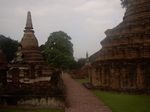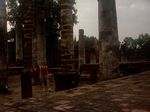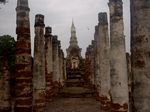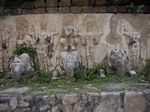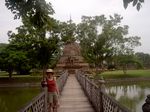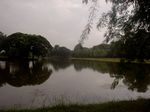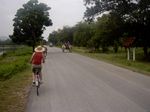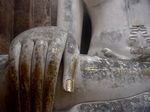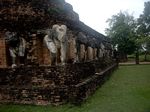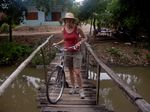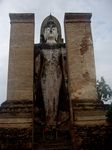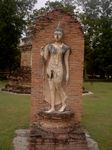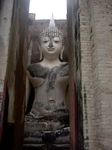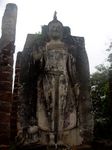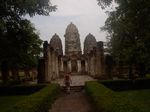Cambodia and Thailand - October, 2005 Asia Trip Home Page
Sukhothai
Ahhh, the serenity of Sukhothai was wonderful after a few days in Bangkok.
To really appreciate Sukhothai one needs to know a bit of Thai history, probably more that I'm willing to provide here. However, here's a link to a web site that has useful information on the subject. If you follow the link, you have to find your way back here on your own.
The various sources of information on Thailand - our guidebook, various web sites and the like - all characterize Sukhothai as the beginning of what eventually became Thailand. While there is plenty of history before Sukhothai, it was here that apparently the language and other Thai characteristics first coalesced. According to those same information sources, most Thais view the Sukhothai period through somewhat romantic eyes, sort of a cradle of their country and a source of national pride.
We wholeheartedly recommend that anyone planning a trip to Thailand devote a day or possibly two to Sukhothai. We were impressed, interested and simply had fun while we were there. The logistics of getting there are pretty simple, but can take some time. In our case, we took the train to a nearby town, Phitsanulok, then a bus to "New Sukhothai" and a tuk-tuk to "Old Sukhothai". It took us all day and involved some (too much) waiting in a local bus station...but we made it and were not disappointed.
The object of our affection is Sukhothai Historical Park, consisting of a central walled area of roughly a mile square, but encompassing many ruins outside the walls as well. Everything is within bicycle distance which we also recommend. There are bikes for rent all over the place for 20 baht per day (50 cents).
The park is very well maintained, groomed even, which we didn't expect. In most areas it was serene, clean, beautiful, etc, and the various ruins were great fun. Some had been restored to an extent. The challenge for restorers is obvious when you think about it. For ruins that are in good shape it may be a matter of simply excavating and providing reasonable access, and perhaps considering how to maintain the present state of preservation. For other ruins in poor condition, how far should restoration go? In the absence of any restoration, some interesting features may not be very attractive. For example, we saw numerous elephant statues in Thailand and Cambodia. Generally, most of these sculptures were 700 to 1,000 years old. Almost without fail, without restoration, they were missing trunks, tusks, ears, etc. Similarly, much of the other statuary we saw in was headless, crumbling, etc. Some of it was left in its natural weathered/damaged condition. However, a great deal of restoration work has been done at Sukhothai and elsewhere (Angkor Wat and surrounding areas) and if it was done well, we came to accept that it added to the quality of our visit. Restoration is a controversial topic and we are not very knowledgeable about it...but overall we felt that the restoration efforts at the ruins we viewed struck a fair balance. For example, it was apparent that some of the large Buddha images we saw, particularly at Sukhothai, had been restored. Otherwise, exposed to the elements as they are, they would have undoubtedly been badly damaged after 800 years (as were some of the unrestored pieces). However, in cases where they had been restored carefully and apparently meticulously, they looked great - not shiny new but a bit weathered, discolored, etc. Whether their appearance was attributable to thoughtful renovation or simply the elements, we don't know.
Anyway, we stayed at the Vittoon Guesthouse, right at the entrance to the historical park. The location was perfect and their bikes were pretty good. We spent a full day on the bikes with only a couple of hours to recover in the aircon room at midday. Here is some of what we saw:
If you want to skip the larger captioned photos click here for the next section
